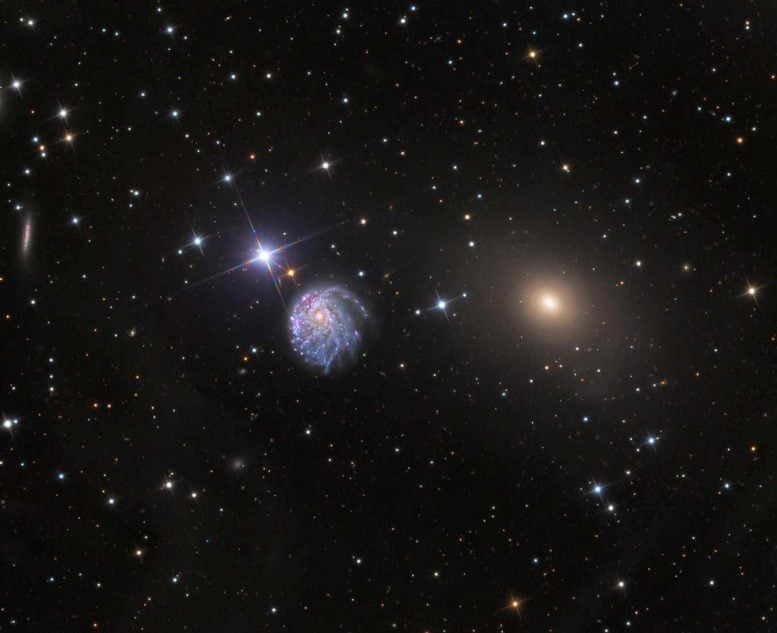
This spectacular image from the NASA/ESA Hubble Space Telescope shows the trailing arms of NGC 2276, a spiral galaxy 120 million light-years away in the constellation of Cepheus. At first glance, the delicate tracery of bright spiral arms and dark dust lanes resembles countless other spiral galaxies. A closer look reveals a strangely lopsided galaxy shaped by gravitational interaction and intense star formation. Credit: ESA/Hubble & NASA, P. Sell, Acknowledgement: L. Shatz
This spectacular image from the NASA/ESA Hubble Space Telescope shows the trailing arms of NGC 2276, a spiral galaxy 120 million light-years away in the constellation of Cepheus. At first glance, the delicate tracery of bright spiral arms and dark dust lanes resembles countless other spiral galaxies. A closer look reveals a strangely lopsided galaxy shaped by gravitational interaction and intense star formation.
This striking image showcases the unusually contorted appearance of NGC 2276, an appearance caused by two different astrophysical interactions — one with the superheated gas pervading galaxy clusters, and one with a nearby galactic neighbor.
The interaction of NGC 2276 with the intracluster medium — the superheated gas lying between the galaxies in galaxy clusters — has ignited a burst of star formation along one edge of the galaxy. This wave of star formation is visible as the bright, blue-tinged glow of newly formed massive stars towards the left side of this image, and gives the galaxy a strangely lopsided appearance. NGC 2276’s recent burst of star formation is also related to the appearance of more exotic inhabitants — black holes and neutron stars in binary systems.

This image shows a wide-field view of NGC 2276, a spiral galaxy 120 million light-years away in the constellation of Cepheus. At first glance, the delicate tracery of bright spiral arms and dark dust lanes resembles countless other spiral galaxies. A closer look reveals a strangely lopsided galaxy shaped by gravitational interaction and intense star formation. Credit: Adam Block/Mount Lemmon SkyCenter/University of Arizona
On the other side of the galaxy from this burst of new stars, the gravitational attraction of a smaller companion is pulling the outer edges of NGC 2276 out of shape. This interaction with the small lens-shaped galaxy NGC 2300 has distorted the outermost spiral arms of NGC 2276, giving the false impression that the larger galaxy is orientated face-on to Earth.[1] NGC 2276 and its disruptive companion NGC 2300 can both be seen in the accompanying image, which shows a wider view of the interacting galaxies.
NGC 2276 is by no means the only galaxy with a strange appearance. The Atlas of Peculiar Galaxies — a catalog of unusual galaxies published in 1966 — contains a menagerie of weird and wonderful galaxies, including spectacular galaxy mergers, ring-shaped galaxies, and other galactic oddities. As befits an unusually contorted galaxy, NGC 2276 has the distinction of being listed in the Atlas of Peculiar Galaxies twice — once for its lopsided spiral arms and once for its interaction with its smaller neighbor NGC 2300.
Notes
- The actual alignment of NGC 2276 can be inferred from the position of its brightly glowing galactic core, which is offset from the distorted spiral arms.
https://ift.tt/3uJOknD
Science
No comments:
Post a Comment